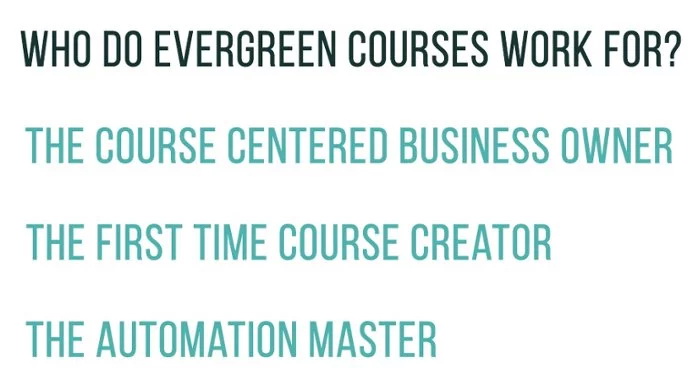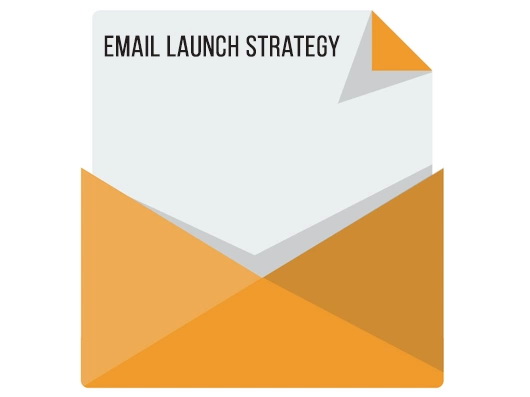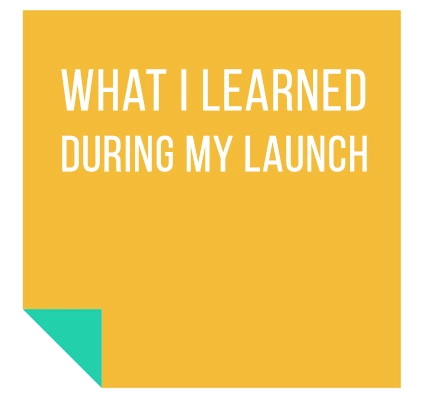When it comes to launching online courses, there is no one “right way” to do so. Sure, we have our standard recommendations that work best for many schools, but like anything, there are exceptions to every rule and what works best for one instructor may not be the best option for you.
We all have our own unique audiences and business models, so of course, we’d want to structure our launches to appeal to the fanbase we’ve worked so hard to grow. But it can be difficult to understand the different launch methods, and even harder to decide which is best for your business. This post will walk you through the different launch methods, their pro’s and con’s, and who they tend to work the best for.
Evergreen course launches
Having an evergreen course launch means that you’ll launch your course once and then it’ll be available from that moment on. We most often see this type of launch with course instructors who have an entire school full of multiple courses for their students to choose from. With that said, there are plenty of instructors who only have a course or two and keep it evergreen indefinitely.
Pros of an evergreen course
- Students can find and buy your course whenever they’d like, they don’t have to sign up for a waiting list before they buy
- If you have a large audience or are a thought leader in your area, you shouldn’t have trouble getting consistent sales even if you’re not launching over and over again
- You put in the work of creating and launching a course once, and then it keeps making money without added effort
- You can still “relaunch” from time to time by educating your audience on why your course is useful and send launch sequences to see a surge of enrollments
- It makes it easier to impulse buy—if someone sees your course and wants it now they may be put off by having to wait until you launch again
Cons of an evergreen course
- If you don’t automate promotion or mention your courses on your website and blog posts, it’ll be easy for your potential students to never click your “courses” or “shop” tab on your site
- You’ll miss out on the urgency of a countdown to close timer that can help urge people to buy
- People can procrastinate on buying your course until they forget about it altogether
The verdict on evergreen courses
They work wonderfully for some businesses, not so great for others. (Don’t you just love vague answers?) So who do evergreen courses work for?

If you’re one of these people, evergreen courses might be for you.
The very busy entrepreneur who has multiple revenue streams. We have thousands of instructors who all have different business models. If you want courses to be something on the side to bring in a little extra cash without much stress, evergreen launches may be for you.
The academy creator who plans on have dozens, or even hundreds, of online courses. You’re the ones who are churning out online courses like it’s your job (and maybe it is!) and there is no way you could possible do open–close launches for every single one. It makes more sense for you to promote your school as a whole rather than each of your individual courses.
Someone with a huge fan-base who many new people coming to their site every day. If you have a large and engaged audience, chances are they’ll buy whatever you create no matter how you launch. These are people whose audience is invested in both their businesses and in them as a person.
The anatomy of a successful evergreen course funnel
Here’s the deal: evergreen courses can be something you launch once, add a link to on your website, and then forget about completely. Or, while you’re launching you can put systems in place to automate promotion and keep your evergreen course profitable throughout the year.
Element 1: The evergreen blog post
Write an actionable blog post that can serve as a precursor to your online course and entice people to buy. The blog post should be thorough and really show your expertise. Optimize it for search terms your potential students will be Googling, and make sure it’s something that will be relevant year round.
There should be a call to action urging people to check out your online course. You can publish this on your own website if you have traffic, otherwise consider posting it on Medium or Quora.
Make sure that this blog post is evergreen and will be relevant no matter when your audience finds it. Here is a guide to writing killer evergreen blog content.
Element 2: Social media automation
Use your favorite automation tools to schedule tweets and Facebook posts sending people to your course sales page and the blog post you wrote promoting your course. Keep the course on your audience’s radar without spamming them with it.
Element 3: Host webinars
Webinars are a big part of most successful open–close launches, but they can also serve you well in your evergreen course. If you know the first Saturday of every month or quarter you’re going to host a webinar and live Q&A covering your course topic, it can become routine, especially if it’s the same webinar each time. Make sure to offer your live audience an exclusive coupon or bundle to encourage them to buy!
You can also host pre-recorded webinars for this step so you do the webinar live once and then play the same webinar back each month. Warning: Be honest! Don’t try and tell people this webinar is live when it’s not.
Element 4: Automate email launches
Chances are, your business is growing every day and your email list is constantly being populated with new members. Segment your list into people who have and have not received a launch sequence about your course. Depending on how quickly your list is growing, you can automatically start launching to new members every couple of weeks or months.
Open–close course launches
We see a lot of open–close launches here at Teachable and for good reason. If done right, the open–close model is very profitable and is what a lot of our most successful instructors do. The idea of an open–close launch is that you’ll create the course once, and then host huge launch campaigns several times throughout the year.
These types of launches help create urgency and excitement. Making your course available for only weeks out of the year can give people a “now or never” mindset that pushes them to take the plunge and purchase.
Pros of an open–close course
- You’ll likely do a better job keeping your online course on your audience’s radar
- You’ll have incredibly profitable months that will have you feel like you’re rolling in $$$
- You can reuse the same email campaigns over and over again so you only have to do the work once
- You’ll be creating urgency. If someone is on the fence and there is only an hour left to buy, they won’t have much time to contemplate before purchasing
- Your students will be going through your course at the same time making community building easier.
Cons of an open–close course
- They are a lot of work—every few months you’ll find yourself setting up your webinar space, looking through email analytics, and fielding questions from prospective students.
- You’ll spend so much time devoting to your launches it’ll be easy for other priorities in your business to be tossed aside.
- It can be easy to get burnt out on this model. Your first few launches might be thrilling and exciting, but after that wears off you might just feel overwhelmed.
The verdict on open–close launches
They are profitable and successful if you have the time and bandwidth to execute them the right way. So who open–close courses work for?

If you’re one of these people, open–close courses might be for you:
Someone whose business model is course-focused and plans on making the majority of their income from online courses. If courses are your online business, it’s worth investing time and trying out the open–close model that works for so many people.
The first time course creator who wants to get a taste of all sorts of launches. If you hate the open–close model, it’ll be easy to open your course up for good. But you never know if you never try.
Someone who is good with automation and can streamline the process. It’s no lie that you’ll see amazing results from an open–close course model, but it comes at the cost of being a time intensive process if you’re not automating all that you can.
The anatomy of a successful open–close course funnel
If you’re creating an open–close launch model for your online course, know this: There are countless moving pieces to this type of course launch, and no two open close launches are going to look the same.
With that said, there are some elements that will be consistent for most everyone, so we’ll start with those.
Element 1: The email marketing campaign
If you didn’t already know how psyched about email lists and marketing we are here at Teachable, well, we will tell you. Over and over again we see course creators getting their best conversion rates from their email lists, because the people who sign up for your list tend to be your most engaged fans.
We recommend sending emails over at least 5 days to educate your audience on why they’d want your course, what you have to offer, and how they can buy. But more on that here.
Pro tip: Save these emails. You can repurpose them for your next launch so you don’t have to start from scratch.
Element 2: Social media campaign
While email lists are king, we shouldn’t discount the power of a strategic social media campaign. Let people on your Facebook page and Twitter know about your course, and share about it in different groups you’re in online (after checking the rules, of course.)
Depending on how often you regularly post on social media, schedule promotion posts to go out between once and five times a day. The goal is to make sure your audience is aware of your course without making course promo every tweet in their timeline.
Again: Save these social shares in a doc so you won’t have to start from scratch on your next launch.
Element 3: Create urgency using a countdown timer
Allowing your audience to see the time to purchase your course slip away is powerful. In themselves, open–close courses will create urgency, but your language and marketing should also be working to accomplish that same goal.
Element 4: Host webinars
This steps converts like crazy whether your launch is evergreen or open–shut. Webinars are a great way to educate your audience on why they’d want to know about your topic, prove you’re an authority, and help forge a connection between you and your audience.
You can incentivize people to purchase by offering exclusive “fast–action bonuses” for your webinar audience. These can be bonuses or discounts that are only redeemable during and directly after your webinar, creating even more urgency.
Deciding what launch is right for you
We talked about the main archetypes who choose each type of course launch, but maybe you find yourself identifying with a mix of personas, or you don’t see yourself in any of the people earlier described. No worries.
Launch strategy is important, but which launch strategy you choose to implement is less so. As long as you’ve got a solid product and an interested and engaged audience, you’re likely to find success no matter which method you choose.
When it comes down to it, think about your business goals, your free–time, and the resources you have available to you. If all else fails, do an open–close launch once to see how it feels, and if it’s not your cup of tea you can just permanently open your course for enrollment.
Writing launch emails

No matter what launch you’re doing, a solid email sequence advertising your course and urging people to buy is essential. Your launch emails should have two phases: education and promotion. Your goal is to generate demand for what you’re teaching by educating. You need to create an understanding of your product and build trust through high-quality content.
During the education phase you need to educate your audience on your course topic and its value. If you’re teaching an online course on SEO for bloggers, first teach your audience what the heck SEO is. Your following email can let them know how you tripled your blog traffic by focusing on SEO.
Overall, you want your audience to understand that what you’re teaching is valuable and worth their time.
Have a promotion strategy
It’s easy to not to want to educate your audience too much for free, the mindset is that if you’re teaching them everything now why would they want to buy? But really, even if you give 20% of your content away for free, that is enough to hook them and make them even more likely to buy.
You should send:
- Targeted blog posts
- Webinars
- Videos
- Any other content that shows students what you have to offer
During the promotion phase you can start selling. Let your audience know that SEO changed the course of your blogging career, opened doors you never thought imaginable, and you want to help them reap the same benefits.
Give them a follower exclusive coupon code or bonus that only the people on your email list will get, to create urgency. (This is especially great if your launch is evergreen!) You can have the coupon available for a limited time, or opt to offer it to only the first 100 purchasers.
Want more on launching to your email list? Check out this post walking you through our Crazy 8 Launch Strategy.
{{threesteps-component="/blog-shortcodes/blog-popup"}}
Automating your course launch
No matter what type of launch you opt for, it’s good to somewhat automate to save yourself time. There are the big obvious ones, like automating email and other small strategies.
Email automation
This one you’ve probably gotten figured out already. But before launch day, write all of your emails in advance and schedule them into your email marketing program of choice. Have them scheduled and ready to go.
There are a million moving parts when it comes to course launches, and it can be easy to say, “Oh, I’ll write the emails as I send them.” But 10/10 instructors who have tried that will tell you it’s a mistake. You will have enough inbound messaging that you’re not going to even want to think about writing emails throughout the day.
If your audience is large, it might be a good idea to turn on an autoresponder letting people know that you’re launching and may take a bit longer than usual to respond.
Automating email responses
No matter how thorough the FAQ page is on your website, people will still bypass it and email you their questions. Having a canned response will save you a ton of time when it comes to answering questions that are being asked repeatedly.
You can anticipate questions like, “How long until the doors close?” or “How many videos are in the course?” As questions come in, you can copy and paste your responses into a Google Doc for future reference.
Ending your emails with, “If you have any more questions, feel free to refer to my FAQ, and if you can’t find your answers there, shoot me an email. Always happy to help!” will help direct people to your FAQ before relying on email.
Automating social media
When you’re busy with your launch you probably don’t want to be spending a bunch of time on social media. Queue your posts ahead of time. It will be one less thing to worry about.
Normally, we’d advise against being too heavy handed with self-promo. However, during your launch you can get away with posting more links to your sales page than usual.
Take notes

The last piece of advice we want to leave you with is document everything. You might feel like you’re going to remember the nitty gritty details, but course launches move fast. After it’s over, you’re going to have a lot to deal with, so be thorough in noting what works and what doesn’t.
Next time, you’ll have a better understanding of what your audience responds to. This can help you be more strategic in the future and will equal more profitable launches for you.
Join more than 150,000 creators who use Teachable to make a real impact and earn a real income.


.png)




